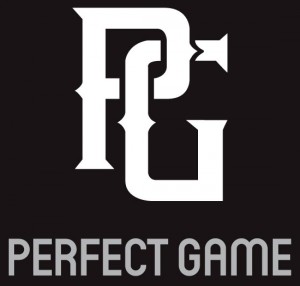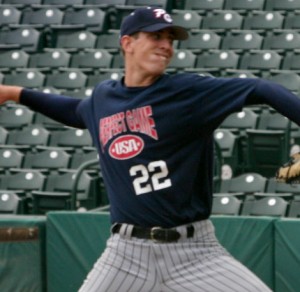Feature Photo: Matt Harvey (Photo by Perfect Game)
The fourth installment of our PG in the Pros series follows the progress of Matt Harvey from a 16-year-old flamethrower to a 21-year-old first-round pick of the Mets in the 2010 MLB Draft.
 There is a popular scouting theory that says that pitchers from the Northeast develop later than their counterparts in the southern tiers of the country. The theory is widespread and easy to understand. Young pitchers from that region simply don’t get as much time outside throwing and building their arm strength in their formative years. In the days before widespread summer and fall travel ball, there were also few opportunities for players from that region to get exposure to southern colleges, not to mention exposure to professional scouts.
There is a popular scouting theory that says that pitchers from the Northeast develop later than their counterparts in the southern tiers of the country. The theory is widespread and easy to understand. Young pitchers from that region simply don’t get as much time outside throwing and building their arm strength in their formative years. In the days before widespread summer and fall travel ball, there were also few opportunities for players from that region to get exposure to southern colleges, not to mention exposure to professional scouts.
None of that especially applied to Matt Harvey, a Mystic, Connecticut native whose parents both attended the University of Connecticut and whose dad, Edward, actually played center field on the UConn team that advanced to the 1972 College World Series.
Harvey was listed at 6-foot-4, 195-pounds when he first appeared at the 2005 WWBA World Championships in Jupiter, Florida, during October of his junior year at Robert E. Fitch High School, when he was 16-years-old. He topped out at 94 mph with his fastball to go with a low-70s curveball while pitching for the East Coast Grays travel team. Some of the scout comments in the Perfect Game database from that 2005 event include “has lightning in his arm! Super-fast arm, good life on his fastball, rolling action on his curveball, needs some refinement in mechanics, cross body in release and will occasionally cut off out front; hooks curveball.”
Harvey pitched at five other PG events while in high school, including the 2006 Aflac All-American Game (now the PG All-American Classic). He was very consistent in his velocity, always topping out in the mid-90s, and his curveball developed well during that time in both power and spin. He also dabbled in a changeup but rarely used it. Notably, there is no record of his throwing his trademark slider in high school.
Two themes were constant in looking through the notes from those events. The first was that Harvey came by his mid-90s velocity very easily. There wasn’t much effort in his delivery and the ball just exploded out of his hand. The second was that he was consistently able to work down in the strike zone with heavy sinking life on his fastball. That is something that precious few high school pitchers can do, especially when they throw that hard.
In addition to many of his Perfect Game appearances, I also saw Harvey throw two innings at the 2006 East Coast Professional Showcase. The comment I wrote afterwards is pretty self-explanatory. “It would be hard to improve on Harvey’s performance; six straight strikeouts, mostly 94 mph on his fastball, pinpoint control. His curveball had plenty of tight spin and bite but wasn’t the true power breaking ball we’ve seen previously at only 74 to 75 mph. Harvey, and not Rich Porcello or Michael Main, is the lead RHP in the 2007 high school class right now in my opinion.”
Another real and inescapable issue with being a high school pitcher in the Northeast is that the short spring baseball season combined with the harsh baseball weather can keep scouts from seeing pitchers at their best. Harvey wasn’t quite up to the previous summers’ standards of stuff and command in the spring, but Perfect Game still had him ranked fourth in the 2007 class going into the draft behind Porcello, Jason Heyward and Josh Vitters.
Harvey was advised by Scott Boras even back in his high school days. That itself scared away many teams, as did Harvey’s asking price of a $2 million signing bonus. The Angels took a flier on him in the third round with the 118th overall pick and reportedly got their offer up to $1 million, but Harvey stood firm and fulfilled his commitment to attend North Carolina University.
Harvey had a solid freshman year pitching in the ACC, going 7-2 with a 2.79 ERA, working mostly as a starter and with a short leash on his innings. He struck out 80 hitters in 67 innings but also walked an uncharacteristic 47 hitters.
His sophomore season was a mess, however. He repeated his 7-2 record but it was accompanied by an unsightly 5.40 ERA. He allowed 88 hits in 75 innings, including eight home runs, and still struggled to find the strike zone, issuing 42 walks. Harvey became more of an enigma at that point to scouts rather than a potential first-round draft pick. Everyone knew the stuff was still there but all the other pieces, including the mechanics, consistency and the competitiveness, all seemed to have waned.
That changed entirely his junior year. The numbers improved dramatically, with an 8-3 record and 3.09 ERA in 96 innings, with 35 walks and 102 strikeouts. Harvey also averaged nearly seven innings per start and was carrying a mid-90s fastball deep into his sometimes very high pitch counts, with one story making the rounds of his throwing 96 mph on his 146th and last pitch of a game. His newly developed slider was also showing itself to be a true power offering, sitting in the 85-to-87 mph range with hard spin and bite. What also stood out was Harvey’s newfound level of competitiveness and fire. He wanted the ball and seemed to get better as games progressed, even doing his own Justin Verlander imitation of seeing his velocity climb steadily during an outing.
The top three prospects in the 2010 MLB First-Year Player Draft were, by consensus, Bryce Harper, Jameson Taillon and Manny Machado and they indeed went with the first three picks. The Mets picked seventh and published accounts afterwards said that they had Harvey as fourth player on their draft board. They had to wait out Kansas City (infielder Christian Colon), Cleveland (left-hander Drew Pomerenz) and Arizona (right-hander Barrett Loux) before they could pick Harvey. Harvey signed for a $2.525 million signing bonus, but in recognition of his long college season and high pitch counts, did not make his professional debut until 2011.
Following 46 starts, 245 innings, and a combined 3.48 ERA in his two minor league seasons, Harvey lived up to his billing, striking out a franchise-record 11 batters over 5 1/3 innings pitched in his major league debut against the Arizona Diamondbacks on July 26, 2012.



